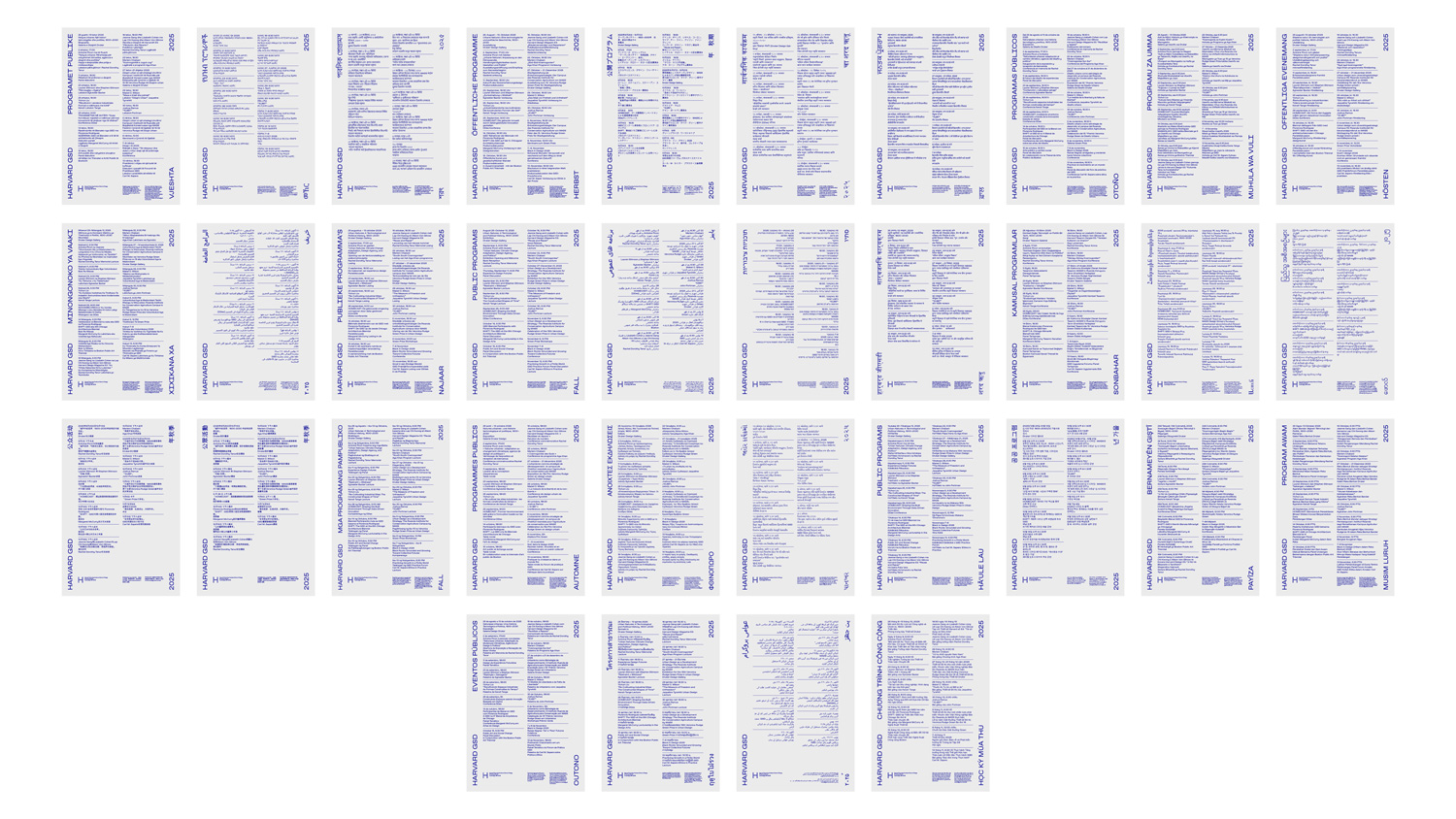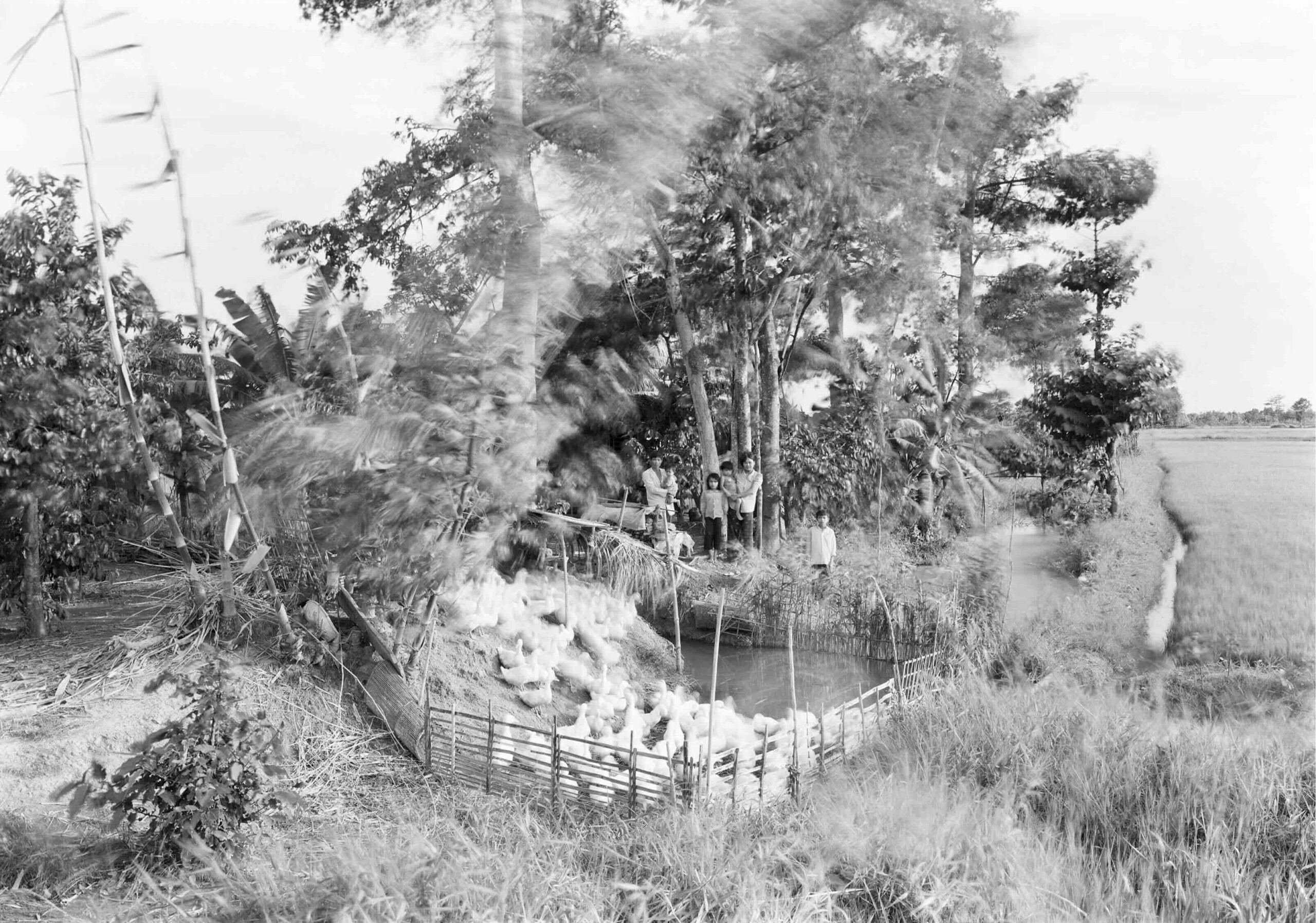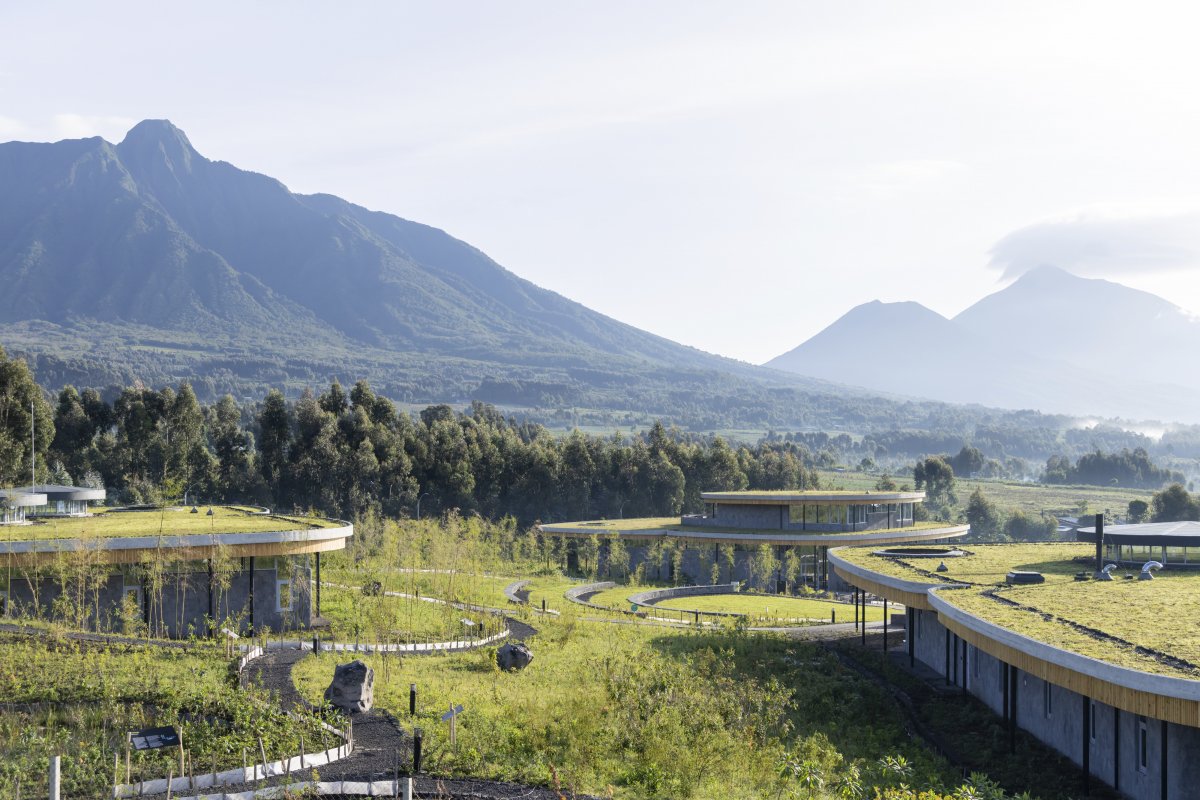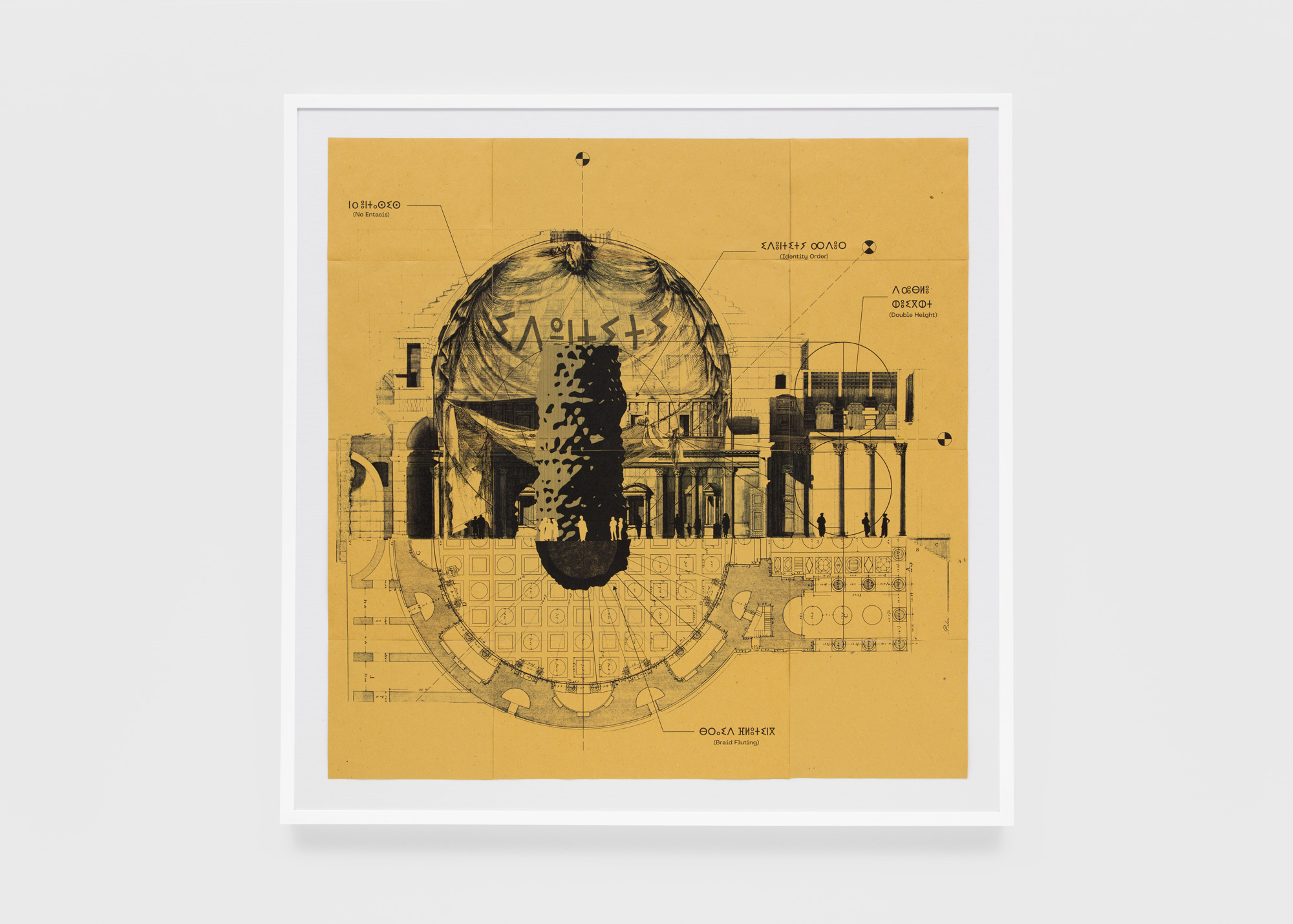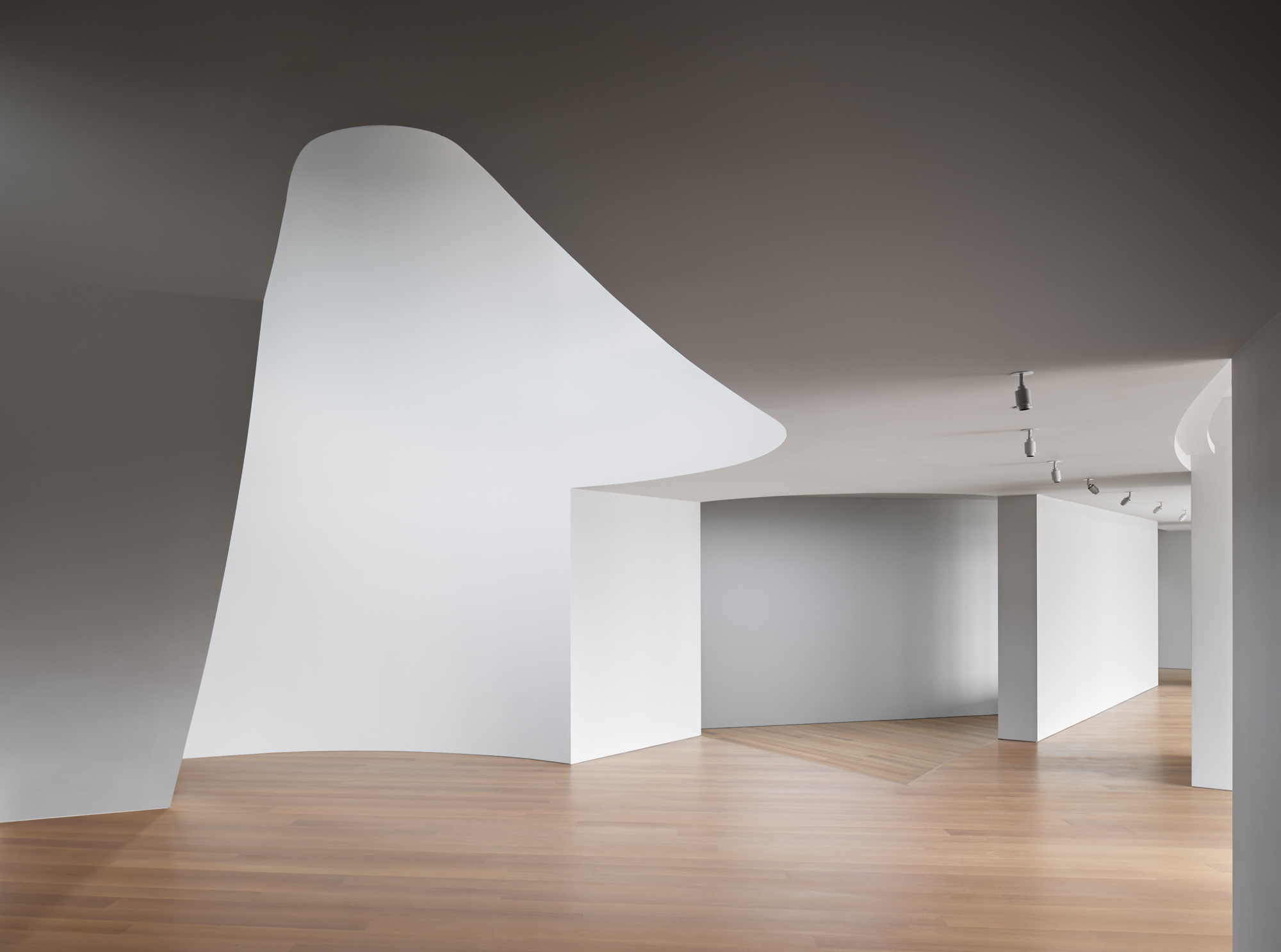The GSD Speaks Your Language
Students at the Harvard Graduate School of Design come from more than 60 countries and speak at least 56 languages, with 34 of them being students’ first or preferred languages, according to a survey of current and incoming students in July 2025. The visual identity of our fall 2025 public programs is translated into those 34 languages, celebrating the internationality of the GSD community.
The project was possible only with the assistance of student and alumni volunteers who translated and reviewed the posters. Among them is Adria Meira (MDes ’26), a Brazilian student who translated the Portuguese version of the poster. “Ensuring that the poster appeared in Portuguese was important to me as a representation of my culture, language, and country,” says Meira.
Valentine Geze (MDE ’26), worked on the French version. “I wanted to support this project because I see translation as a way to both welcome and celebrate the diversity of the GSD,” says Geze. “Supporting immigrants and honoring the languages spoken here feels especially important now; making space for many voices expands the perspectives that shape our academic and personal experiences.”
In past years, the GSD has collaborated with designers to create unique visual identities and promotional materials for the public programs. This year, the GSD’s own art director Chad Kloepfer, and Willis Kingery, graphic design consultant, designed the posters to represent the linguistic diversity of the GSD.
This multilingual project highlights the GSD’s commitment to welcoming students from around the world. “The GSD is one of the most international schools at Harvard,” said Dean Sarah Whiting in spring 2025. “Our international makeup goes back to the founding of the GSD. It is part of our DNA—our student body, our faculty, our staff, and the discipline and practice of design all thrive on this internationalism. The extraordinary breadth of experience and perspectives that the international members of our community provide is essential to who we are.”
Meira is part of the international community that Dean Whiting described. For her, participation in the poster project is “a way to highlight the contributions of the Brazilian community, which has 12 members at the school.” The student organization Brazil GSD, of which Meira is a part, “enriches the life of the school for everyone and provides much needed support to those of us studying far from home at such a challenging time.”
| Language | Translators |
|---|---|
| Amharic | Anonymous |
| Arabic | Sara Abduljawad (MLA ’27) |
| Armenian | Shant Armenian (MArch ’28) |
| Bangla | Anonymous |
| Burmese | Htet H Hlaing (MArch ’26) |
| Chinese (Simplified & Traditional) | Anson Leung (MLA ’26) |
| Dutch | Emma van Zuthem (MDes ’27) |
| Farsi | Soroush Yeganeh (MArch ’26) |
| Filipino | Maita S. Hagad (MLA ’28) |
| French | Valentine Geze (MDE ’26) |
| German | Robin Albrecht (MArch ’26) |
| Greek | Styliani Rossikopoulou Pappa (MDes ’19) & Alkiviadis Pyliotis (MArch ’20) |
| Gujarati | Aum Gohil (MAUD ’27) |
| Hebrew | Anonymous |
| Hindi | Malvika Dwivedi (MDes ’27) |
| Japanese | Anonymous |
| Korean | Jeongjoon Lee (MArch ’27) |
| Kurdish | Leyla Uysal (MDes ’24, MLA ’27) |
| Malay | Joshua Teo (MDes ’26) |
| Marathi | Riddhi Kasar (MDE ’26) |
| Portuguese | Adria Meira (MDes ’26) |
| Punjabi | Anonymous |
| Spanish | Dana Barale Burdman (MDes ’26) |
| Swahili | Martha Oloo (MLA ’27) |
| Swedish | Hannah Ahlblad (PhD ’30) |
| Thai | Sirinda (Kaew) Limsong (MDE ’26) |
| Tsonga | Xiluva Mbungela (MDes ’26) |
| Turkish | Defne Ergun (MArch ’28) |
| Urdu | Omer Yousuf MUP ’26 |
| Vietnamese | Tuân Cao (MAUD ’27) |
Translation of Albanian and ʻŌlelo Hawaiʻi (Hawaiian) was provided by We Are Very.
The Final Experience is Beyond Our Control
This month marks the fiftieth anniversary of the fall of Saigon, a time An-My Lê remembers vividly. As she recalled during her Rouse Visiting Artist Lecture at the Graduate School of Design (GSD) this month, Lê and her family were among the hundreds evacuated from Vietnam by US soldiers. When she left, she was just fifteen years old, and, because of the war, had never had access to the Mekong Delta. Her only memories of the place were images she’d seen of GI’s being airlifted out. Nearly twenty years later, working under a grant after graduate school, she went back to photograph it.
“Exploring the landscape was a complete adventure,” said Lê, describing her return in 1994, when the United States re-established relations with Vietnam. “Living in exile,” she explained, “means not having access to your culture. For many years, we did not think we could return to Vietnam, and once I got there, I realized that all these memories were not very reliable.”

Speaking at the GSD on April 1, Lê described how she made repeated visits to make landscape photographs with a view camera. The cumbersome but essential tool allows her to capture vast landscapes and poignant portraits, with long exposures that often create “happy accidents.” Back in Vietnam, she quickly found resonances of not only her childhood and the war, but also centuries past emerging in her images. The blurry palm trees above a flock of ducks, depicted in “Untitled, Mekong Delta, 1994,” could have been preserved from another lifetime, long before the war made travel in the Mekong Delta unsafe and damaged the landscape.
Lê pointed out the similarity between her work as a photographer and that of landscape architects in terms of time and history. Landscape architects design spaces we experience in the moment that also make reference to history and suggest potential change. According to Lê, photographers layer their images with “notions of the past” and future. She said she looks at the landscape like a designer when she thinks about the separation between earth and sky, or questions of scale.
“I love the freedom,” she said of her medium. “You can start anywhere. And yet, we do our best to provide specific elements—whether a landscape architect designs a particular hill or curve, or how I choose to frame an image—but, the final experience is something we can’t control.”
In 1999, at the invitation of a group of Vietnam War reenactors who stage battles in Virginia and North Carolina, she began to photograph images of war—or at least, a mimicry of it. She often participated in the events herself so that she could remain close to the action, posing as a spy or soldier. The resulting images—a cluster of soldiers converging in a small opening in the woods blurred by a stand of bamboo they’d planted, the sparks of a bomb splashing into the air like a fountain—reveal the moments she found most interesting, which, she reminded the audience, is not the same as the photojournalistic impulse to record what’s “most pressing.”
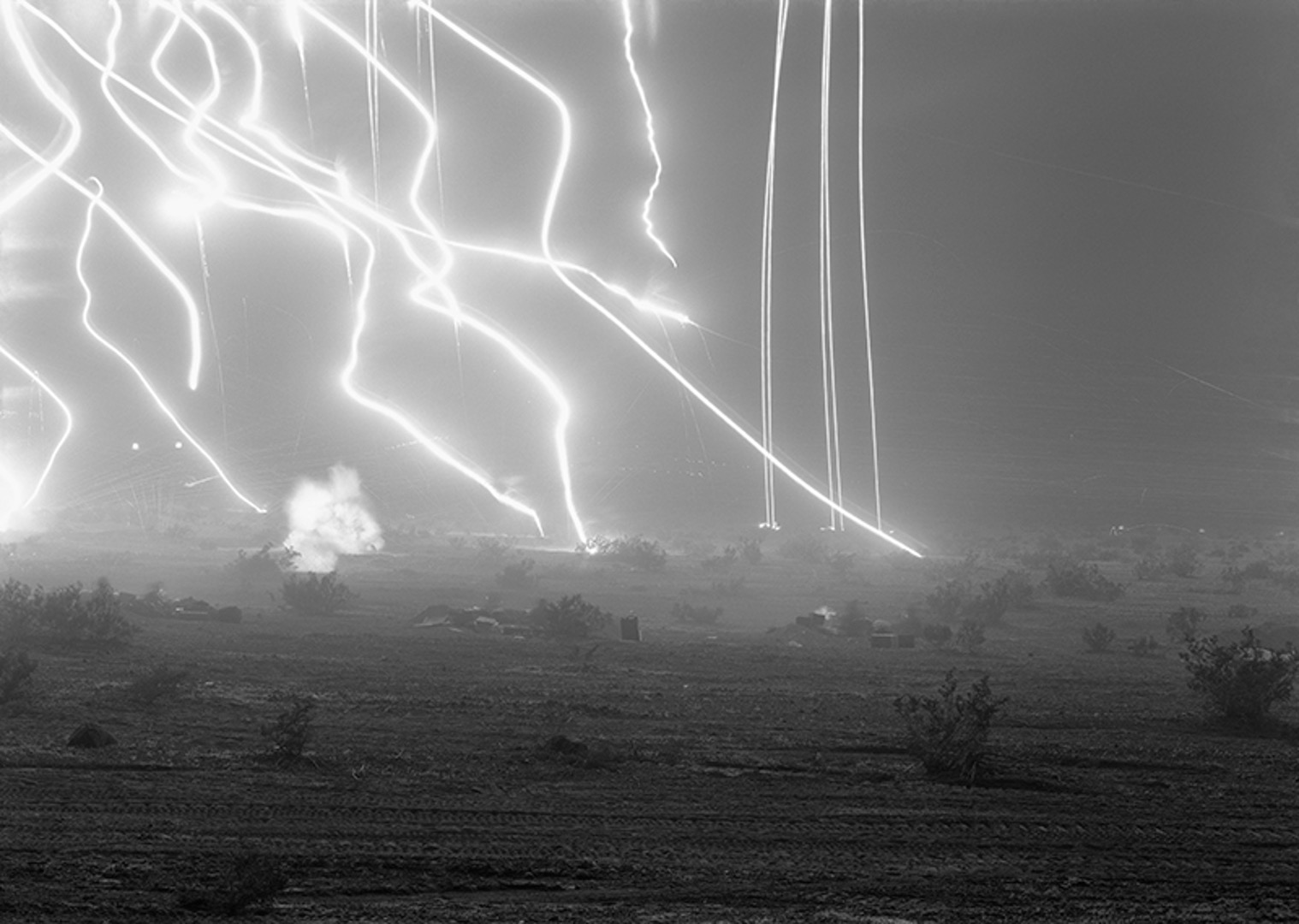
Since then, she has observed military trainings in the Southern California desert that prepared soldiers for the Iraq and Afghanistan Wars, traveled on US navy ships across the Pacific, visited army training sessions in Ghana, and observed earthquake relief efforts in Haiti. Images from these travels became part of her series “29 Palms” (2003) and “Events Ashore” (2005–2012). She has also continued to attend war reenactments and was invited to shoot at the Louisiana filming of Free State of Jones, about the Civil War. While she often pursues “hot button topics,” she approaches those issues not from a documentary perspective but with poetic language, explaining that the building blocks of language and the photographic worlds she creates are very similar in terms of establishing tension, perspective, and the marriage of form and content.
In 2022, Lê began to experiment with the cyclorama, a form popular before the moving image that surrounded viewers with monumental paintings on the walls of a circular room. She reimagined the genre by hanging a series of large-scale photographs side by side around a circular room, allowing people to read them in linear and nonlinear fashions.

She used the cyclorama to present narrative photographs in the 2024 series “Dark Star” and “Grey Wolf.” Shot at a national park in Colorado near a nuclear missile test site, the images in “Dark Star” depict the vast night sky, capturing with a long exposure the thousands of stars invisible to the naked eye, and urging the viewer to consider “civilization and the infinite world beyond us”—perhaps even offering comfort, Lê explained. “Grey Wolf,” a series of photographs shot from a helicopter over the missile installations set amid farmland in Montana and Nebraska, was inspired in part by the history of Land Art. The sites and their context evoke the monumental earthworks and concrete structures that comprise artist Michael Heizer’s Nevada project City, which stretches across over a mile of the desert. “The size of the stones on the path, the color of the stones, the height of the sidewalk, the borders, the plants—it’s very specific.” Lê cites Heizer as a contemporary influence.
She also engages deeply with the history of her primary medium and acknowledges nineteenth-century war photographers Timothy O’Sullivan and Roger Fenton as influences as well. Because war and its aftermath has been her subject for much of her career, Lê has had to wrestle with the question of whether she’s rendering violence “beautiful.” Her landscape photographs have been compared to the work of Robert Adams, and challenge our perception of the narrative a war image can tell. She argued that she’s in search of something beyond beauty—the sublime, or ineffable.

Her use of the view camera helps advance that goal. While she tried a smaller camera that allowed her to move with more agility, she was dissatisfied with the images; cumbersome though the view camera was, it allowed her to capture the landscape as she perceived it, with its many layers of space, time, and the valances of memory. And as she experimented with portrait photography—for example in her portraits of women on the carrier ships in “Events Ashore”—she also found that the view camera created different experiences with her subjects. When she went under the dark curtain to snap the shot, people posed for the camera, looking into its lens but unable to see her looking back.
Lê concluded her talk at the GSD with discussion of recent work in a new medium, embroidery, in which she considers the “ecstatic sublimity and quasi-religiosity of the frenzied performance.” She creates embroideries based on stills from a pornographic movie ostensibly set during the Vietnam War, in which performers stage an encounter between American soldiers and Vietnamese sex workers. She explained that she’s drawn to needlework because it completely absorbs her attention. “I find comfort when I lose myself in the work.”
She previously made weavings for her “đô-mi-nô” series, and was drawn to embroidery after finding a cross-stitched landscape in the basement of her apartment building. In Lê’s printing process, she edits her photographs at the level of the pixel, and began to think, “maybe that’s the way for me to control the image.” She was also influenced by medieval tapestries that “hang as decorative pieces while also suggesting a narrative. They’re about storytelling.”
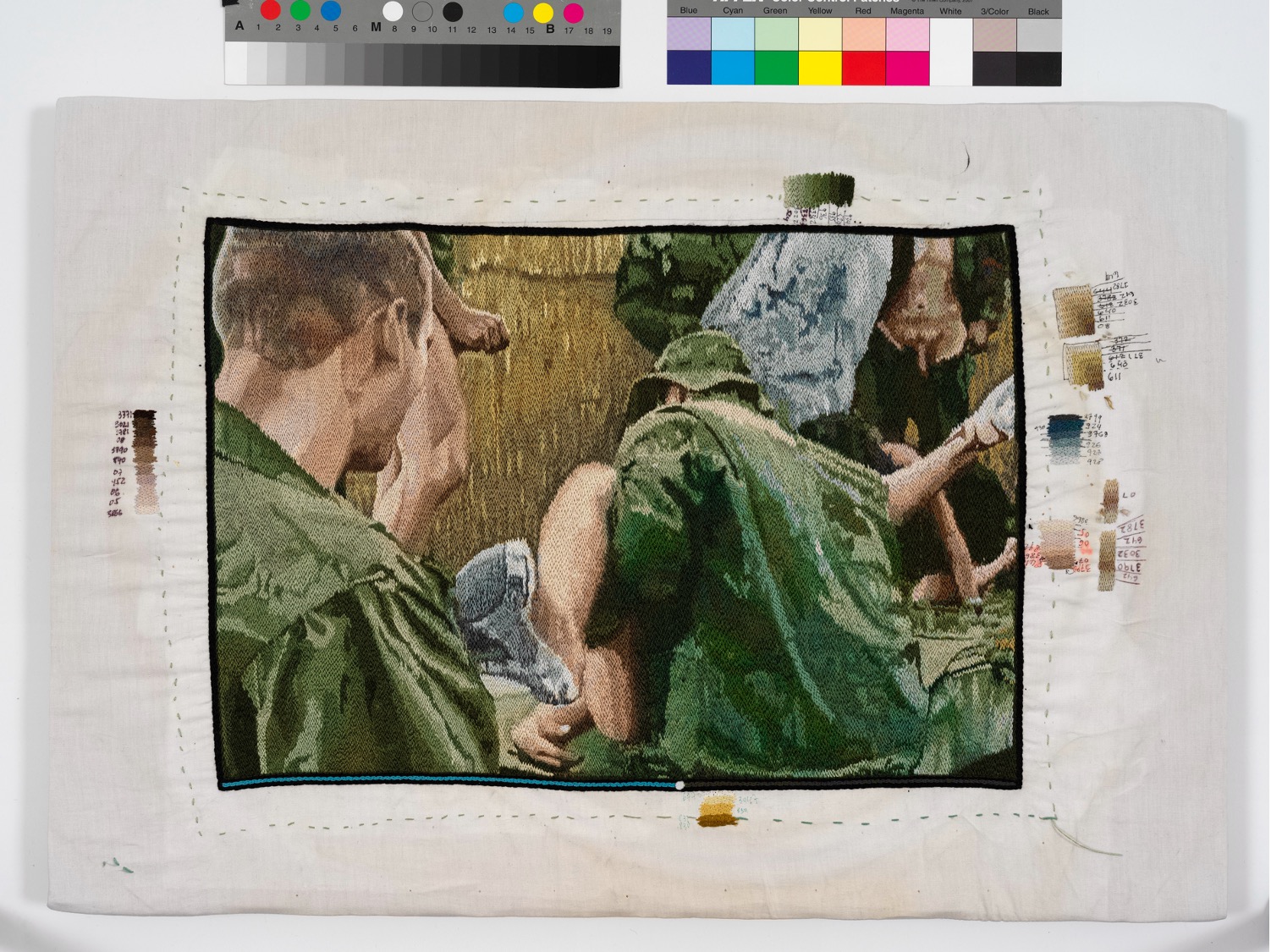
Inspired by the long tradition of embroidery in Vietnam, Lê and her studio assistants create painterly palettes for the images that Lê expanded and cropped, abstracting them beyond the pornographic realm. “It’s not easily decipherable at first,” she explained. “I chose moments when the action is more obscure, which was important to get people to stop and think about the origin of the piece.” For her, the series is about how women “hustled during the war,” as well as the “spoils of war,” sex workers, and how the makers of the Vietnam War–themed porn film took a historic and painful time and turned it into entertainment.
Like all of her work, however, she leaves the embroidered images up to the audience to interpret. “Ultimately, you provide an experience that only the audience or the viewer or participant can experience themselves, and you just have to let go.”
The Plural Forms of African Landscape Architecture
“Landscape is a way of beholding that is inclusive of nature and culture, of people and environment,” said Jala Makhzoumi. “It is anchored, it is situated, it is contextualized.” An Iraqi landscape architect based in Beirut, Makhzoumi offered these reflections to encourage expansive thinking about her discipline as part of a two-day conference hosted by the Harvard Graduate School of Design (GSD) and the Department of African and African American Studies. The international participants in “African Landscape Architectures: Alternative Futures for the Field” explored what it would mean for the practice of landscape architecture to be anchored in the continent’s diverse cultures, ecologies, and traditions.
Introducing the conference, organizer Gareth Doherty (DDes ’10), associate professor of Landscape Architecture at the GSD and affiliate of the Department of African and African American Studies, described the tremendous potential to foster landscape architecture as a discipline on the continent as well as the urgency of undertaking socially grounded, culturally relevant design practices there. Doherty was among the speakers who noted that Africa has the youngest population in the world, with approximately 70 percent of people in Sub-Saharan Africa under age 30. By 2050, Africa will be home to some 850 million young people. Such demographic projections underscore the need to create sustainable cities. As Thabo Lenneiye of the University of Pennsylvania observed in her presentation, “African cities and settlements are on the front lines of climate change,” not only threatened by the effects of warming, but also subject to a new, terrain-destroying scramble for the rare earth minerals critical to emerging “green” technologies. As climate change accelerates, designing for resiliency in Africa for Africans may be the most urgent task for landscape architects today.
Meeting these demands requires the broad perspective Makhzoumi offered, as well as the input of artists and philosophers, who were among the conference participants. Pointing to the conference title in his introductory talk, Doherty stressed the need for landscape architectures: “this ‘S’ is very important because it represents a plurality of forms of practice.” Such plurality was evident from the first panel discussion, which featured prominent GSD alumni of different generations. Returning to his alma mater for the first time in 50 years, Johan van Papendorp (MLA ’75) took stock of his career shaping the urban greenspaces of Cape Town, South Africa. Spanning from Table Mountain to the sea, the network of landscapes van Papendorp helped develop was inspired in part by the Boston’s iconic Emerald Necklace park system, created in the nineteenth century by Frederick Law Olmsted.
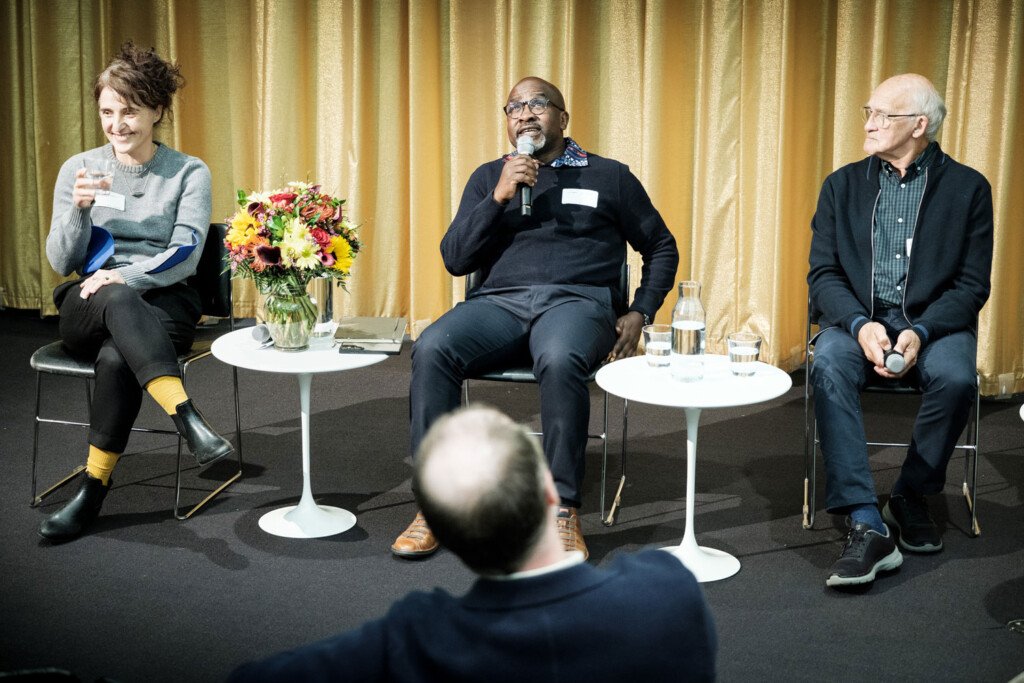
Exemplifying an alternate mode of practice, Arthur Adeya (MLA ’06) and Chelina Odbert (MUP ’07) discussed their work in the Kibera section of Nairobi, a dense, underserved slum whose needs run deeper than green space. Adeya and Odbert instead worked with members of the community to develop “productive public spaces” that offer verdant refuge but also facilities for social gatherings, economic workshops, and public health and education initiatives. While this vision of landscape architecture as community infrastructure developed in Kibera, Adeya, Odbert, and their collaborators at the Kounkuey Design Initiative (KDI) have also applied their methodology to public spaces and community development projects as far away as inland Southern California. “This is really Africa exporting landscape architecture,” said Adeya, reflecting on how their experiences in Kibera have translated to international projects.
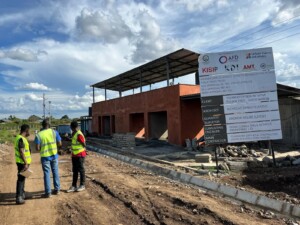
Discussions throughout the conference focused on the need to reverse the colonial logic by which Western models had long been imposed onto African settings. What would a new landscape architecture, rooted in Africa, look like? Doherty spent a recent sabbatical year traveling the continent and visiting academic institutions with landscape architecture departments. The profession itself is in a nascent stage, with only eight of 54 African nations currently home to professional associations of landscape architects. Though increasing, the number of landscape architecture programs at African universities also remains relatively small. Doherty built relationships with many of these institutions. In addition to encouraging virtual participation at the live-streamed conference, he has invited students in Africa to participate in his GSD class as guest speakers.
Still, as speakers on the “Pedagogies” panel emphasized, the growth of academic programs also needs to be matched by the development of an African-centric curriculum. Finzi Saidi of the University of Johannesburg confronted this question as he described his work with Unit 15x at his university’s Graduate School of Architecture. He and his colleagues research “landscapes in post-colonial African societies to propose culturally appropriate designs” reflecting the dynamic conditions of contemporary Africa. Yet within nations grappling with the legacies of colonialism, what might be the basis for such designs? Doherty recalled a workshop that included Saidi and Sechaba Maape of University of the Witwatersrand. The latter relayed his students’ complaints that they were being taught to design cities for white people. Maape responded with a challenge: “Show me what a city for Black people is like.” The answers Maape presented made reference to ancient African ritual spaces, proposing answers to contemporary ecological problems while invoking deeply ingrained spiritual practices that connected people to the land.
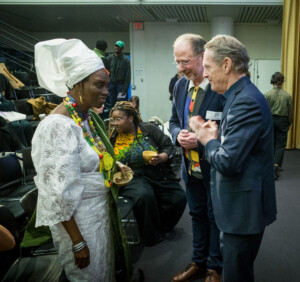
Indeed, the theme of spirituality in landscape design ran through the conference, invoked in the opening session by Jacob K. Olupona, Hugh K. Foster Professor of African and African American Studies and Professor of African Religious Traditions, and chair of the Department of African and African American Studies. Olupona noted that the conference built upon a 2019 gathering at the GSD, also organized by Doherty, focused on the tradition of sacred groves, which are prevalent in West Africa and also maintained by descendants of Africans in Brazil. Forests stewarded by people for the purpose of spiritual expression, sacred groves offer one touchstone for reimagining African landscape architecture in general. The sacred felt viscerally present in the conference from the start as Princess Adedoyin Talabi Faniyi of the Osun Sacred Grove in Osogbo, Nigeria, offered a Yoruba blessing for the proceedings. She also spoke later that night as part of the International Womxn’s Day Keynote event alongside Tarna Klitzner, a designer based in Cape Town, and moderator Zoe Marks, director of the Harvard Center for African Studies. The Princess movingly described how the forests, rivers, and terrain that she oversees “acknowledge the interconnectedness of nature and spirituality.”
This spiritual connection to nature can also serve as the basis for a sharper critique of contemporary political economy and historical power imbalances. Olatunji Adejumo of the University of Lagos argued that Western Enlightenment philosophy, imported to Africa, had informed colonial uses of the land. Adejumo drew a contrast between “Spiritscapes,” defined by a biocentric philosophy and local knowledge, and the extractive logic underpinning the “Resourcescapes” that Africa had become in the colonial imagination. Turning to African traditions and precedents for her own work championing regenerative agriculture and environmental stewardship in the Lake Victoria region, Lenneiye invoked figures like Thomas Sankara, who planted 10.5 million trees in Burkina Faso in the 1980s; Wangari Mathaai, who encouraged women to learn forestry skills in Kenya; and Zephanaiah Phiri, a water harvesting advocate in Zimbabwe. These historical precedents suggest a rich basis for sustainable landscape practices in Africa in the future, what Lenneiye described as “locally relevant, community informed adaptation plans that integrate African environmental philosophies and practices.”
While looking ahead to a future when these philosophies and practices might thrive throughout the continent, “African Landscape Architectures” also featured inspiring examples from the present. Joe Christa Giraso of Mass Design Group, based in Boston and Kigali, Rwanda, provided an overview of the meticulous research that went into the designed landscape for the Ellen DeGeneres Campus of the Dian Fossey Gorilla Fund. Through this scientifically informed landscape design, the campus’s stunning natural setting also became an active research site for reforestation techniques in Rwanda.
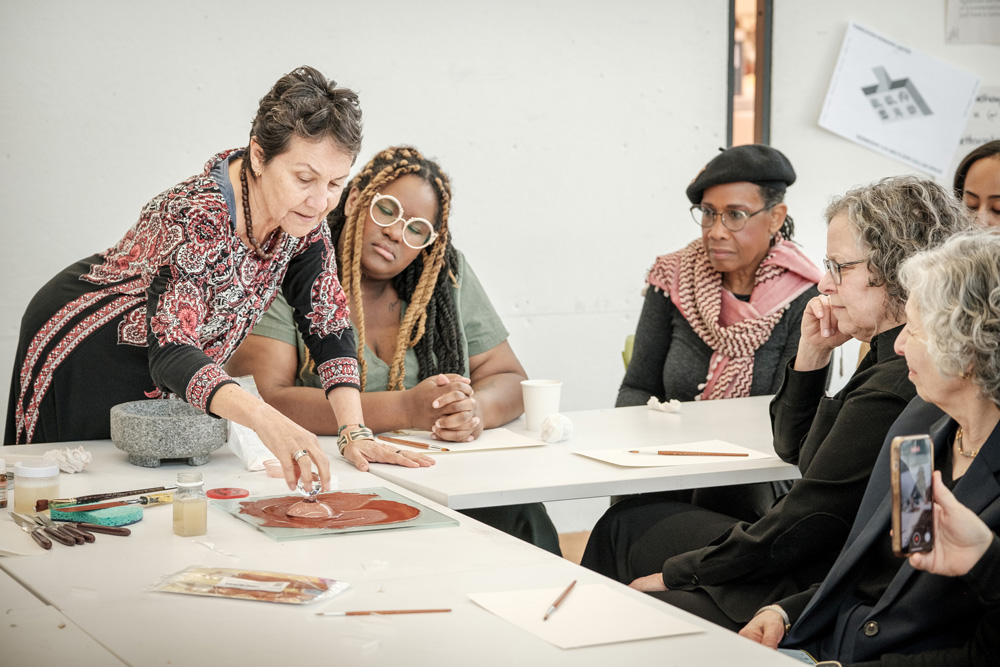
As the scholars and practitioners at the conference made clear, landscape architecture is a growing discipline within Africa, but also a porous one. Makhzoumi, who is also acting president of the International Federation of Landscape Architects, the Middle East Region, argued, “I don’t think landscape is the domain of Landscape Architects.” The alternative futures for the field charted in the conference suggest a new kind of hybridity in line with Makhzoumi’s flexible notion. Through the discussions, it became possible to imagine landscapes in Africa guided by spiritual leaders, artists, agriculture specialists, planners, philosophers, and various communities in partnership with an emerging generation of professionals.
GSD Announces Fall 2024 Public Programs and Exhibitions
The Harvard Graduate School of Design (GSD) announces its fall 2024 schedule of public programs and exhibitions, many of which offer interdisciplinary perspectives on conflict, power, and design as a means of communication.
In the series of events Democracy and Urban Form (October 9–10), Michael Sandel, Richard Sennett, and Diane Davis discuss how the design of our cities can empower citizens and facilitate modes of discourse essential to democratic societies. Senior Loeb Scholar Malkit Shoshan hosts “Reconstruction and Redestruction” (October 24), a discussion about the complexities of postwar reconstruction with Andrew Herscher and Daniel Serwer. In “Building with Care” (September 24), Shoshan develops similar ideas, speaking with Tatiana Bilbao and Elke Krasny about how a powerful shift in worldview can follow from displacing the use of the word “war.”
Foregrounding global perspectives on the power dynamics underlying design history and practice, on October 7, Germane Barnes presents “Where This Flower Blooms,” his Wheelwright Prize research that reinserts North African building practices that were critical to Italian architecture throughout antiquity but erased in Eurocentric histories of design. The talk coincides with Barnes’ first solo exhibition, which opens at the Art Institute of Chicago on September 21. In the 2024 Aga Khan Program Lecture, Iraqi landscape architect Jala Makhzoumi (October 22) searches for a grounded language for landscape architecture in the Middle East that captures the complexity of the English term “landscape.”
Fall programs explore the role of design in mitigating environmental degradation while bolstering social equity and deepening our connections with nature. Anne Whiston Spirn poses direct questions about the connection between climate change and urban landscapes in her lecture, “Restoring Nature, Rebuilding Community” (October 29), while Chelina Odbert (September 12) addresses 15 years of her “mission-driven,” community-engaged design. Surveying the practice of landscape architect Bas Smets, the exhibition Changing Climates (October 28–December 20) demonstrates the power of urban micro-climates in confronting ecological crisis. And Sean Godsell, the Kenzo Tange Visiting Critic, reflects on the Australian bush, a “mystical, mythical” place where water is a most precious commodity (October 17).
Focusing on the practice of design and the tools architects use to develop their work, the exhibition Architecture as an Instruction-Based Art (August 26–October 14), curated by Farshid Moussavi, features construction coordination drawings created by practitioners from around the world. These detailed composite drawings, which Moussavi and exhibition contributors discuss on September 3, are conceptual tools architects use to think through their buildings. Selections of the drawings are also featured in Harvard Design Magazine 52: Instruments of Service (launching October 16), guest edited by Elizabeth Bowie Christoforetti and Jacob Reidel.
The complete public program calendar appears below and can be viewed on the GSD’s events calendar.
Architecture as an Instruction-Based Art
Exhibition
Druker Design Gallery
August 26–October 14
Exhibition Opening: Architecture as an Instruction-Based Art
Farshid Moussavi and guests
September 3, 6:30pm
Eric Höweler, “Clay: Pedagogy and Practice”
Lecture
September 10, 6:30pm
Chelina Odbert, “Situating Justice: Reflections on Mission-Driven Practice”
Margaret McCurry Lectureship in the Design Arts
September 12, 6:30pm
Perfect Days (2023)
Film Screening
September 19, 6:30pm
GSD Comeback: Celebration of Alumni & Friends
September 20–22
Malkit Shoshan, Tatiana Bilbao, and Elke Krasny
“Building with Care: Feminist Perspectives on Design in Conflict”
Senior Loeb Scholar Conversation
September 24, 6:30pm
Signe Nielsen, “Parks and Monuments: A Cultural Evolution”
Lecture
September 26, 12:30pm
RealTimeNature
With opening remarks by Peter Galison and closing keynote by Daniel Barber
DDes Conference
September 27, 9am
Germane Barnes, “Where This Flower Blooms”
Wheelwright Prize Lecture
October 7, 6:30pm
Wheelwright Prize Jury with Germane Barnes
David Brown, David Hartt, Mark Lee, Megan Panzano, and Sumayya Vally
Conversation
October 8, 12:30pm
Democracy and Urban Form
Michael Sandel, “Democracy’s Discontent”
Lecture
October 9, 6:30pm
Democracy and Urban Form
Richard Sennett, Diane Davis, Claire Zimmerman, Markus Miessen, and Guests
Panel Discussion
October 10, 12:30pm
Theodore Spyropoulos, “Quantum”
Rachel Dorothy Tanur Memorial Lecture
October 15, 6:30pm
Harvard Design Magazine 52: Instruments of Service
Issue Launch
October 16, 12:30pm
Sean Godsell, “Your Feet Against My Feet: Upside-Down Architecture”
Kenzo Tange Visiting Critic Lecture
October 17, 6:30pm
Jala Makhzoumi, “Landscape, Garden, and a Colonial Legacy”
Aga Khan Program Lecture
October 22, 6:30pm
Malkit Shoshan, Andrew Herscher, and Daniel Serwer
“Reconstruction and Redestruction: Post-War Antinomies”
Senior Loeb Scholar Conversation
October 24, 6:30pm
The 2024 Ivory Prize Housing Innovation Summit
October 25, 12:30pm
Changing Climates
Exhibition
Druker Design Gallery
October 28–December 20
Anne Whiston Spirn, “Restoring Nature, Rebuilding Community”
Frederick Law Olmsted Lecture
October 29, 6:30pm
Exhibition Opening: Changing Climates
Bas Smets
October 31, 6:30pm
Laurie Olin, “First We Read, Then We Write”
Sylvester Baxter Lecture
November 7, 6:30pm
Sheila O’Donnell, “Conversations with Place”
Lecture
November 12, 6:30pm
A Round Table
Loeb Fellowship Symposium
November 15, 12pm
Symposium in Honor of Giuliana Bruno
With Keynotes by Isaac Julien and Emanuele Coccia
Gund Hall and Carpenter Center for the Visual Arts
November 21
All programs take place in Gund Hall, are open to the public, and will be simultaneously streamed to the GSD’s website, unless otherwise noted.
Announcing the Harvard GSD Spring 2023 Public Program
The Harvard Graduate School of Design (GSD) launches its spring 2023 public program with the opening of the exhibition Grand Paris Express: Reconfiguring the City through Radical Infrastructure, on display through March 31, 2023. A lecture and reception are scheduled for March 2, and an afternoon of workshops surrounding the large-scale transit project will follow on March 3. The Grand Paris Express is the winner of the 2023 Veronica Rudge Green Prize in Urban Design .
Other highlights include: Kotchakorn Voraakhom, who will present a lecture on the challenges that water-based cities face when addressing climate change (January 31). Adèle Naudé Santos will deliver the Jaqueline Tyrwhitt Urban Design Lecture entitled “Narrative Maps: A Design Process” (February 14). For the John Hejduk Soundings Lecture, Stan Allen will discuss his recent book Situated Objects (February 7). Kofi Boone will speak on environmental injustice in landscape architecture and urban planning for the Sylvester Baxter Lecture (February 16). Andrew Bernheimer will present the annual John T. Dunlop Lecture (March 28), with a talk titled “Where is the Architecture? Finding Design and Community Amidst Constraints,” followed by a discussion with Jill Crawford, Marc Norman, and Daniel, D’Oca. And Rouse Visiting Artist Abraham Cruzvillegas will present a lecture titled “Centring: A Definitely Unfinished and Temporary Structure for Art Making” (April 13).
The complete public program calendar appears below and can be viewed on Harvard GSD’s events calendar. Please visit Harvard GSD’s home page to sign up to receive periodic emails about the School’s public programs, exhibitions, and other news.
Spring 2023 Public Program
Kotchakorn Voraakhom, “LANDPROCESS: The Global and Local Climate Adaptation Design”
Lecture
January 31, 6:30pm
Yung Ho Chang, “Form, Content, and Total Design”
Lecture
February 2, 6:30pm
Stan Allen, “Situated Objects”
John Hejduk Soundings Lecture
February 7, 6:30pm
Ana María Durán Calisto, “The Deep History of Amazonian Agroecological Urban Forests: Why Do They Matter Today?”
Lecture
February 9, 6:30pm
Adèle Naudé Santos, “Narrative Maps: A Design Process”
Jaqueline Tyrwhitt Urban Design Lecture
February 14, 6:30pm
Kofi Boone, “Recognition, Reconciliation, Reparation”
Sylvester Baxter Lecture
February 16, 6:30pm
Grand Paris Express: Reconfiguring the City through Radical Infrastructure
Celebration for the 14th Veronica Rudge Green Prize in Urban Design
March 2, 6:30pm
High Performance Public Transportation: Models and Strategies
Green Prize Workshop, Gund 112 (Stubbins)
March 3, 12:30pm
New Stations as Urban Projects: Multiple Dimensions
Green Prize Workshop, Gund 112 (Stubbins)
March 3, 3:00pm
International Womxn’s Week Keynote Address
March 7, 6:30pm
Bas Smets, “Biospheric Urbanism”
Daniel Urban Kiley Lecture
March 23, 6:30pm
Andrew Bernheimer, “Where is the Architecture? Finding Design and Community Amidst Constraints”
John T. Dunlop Lecture
March 28, 6:30pm
Mark Lee, “Five Footnotes Toward an Architecture”
Walter Gropius Lecture
April 4, 6:30pm
Rachel Meltzer, “What We Miss When We Look at Everything: Global Shocks and Local Impacts”
Lecture
April 11, 6:30pm
Abraham Cruzvillegas, “Centring: A Definitely Unfinished and Temporary Structure for Art Making”
Rouse Visiting Artist Lecture
April 13, 6:30pm
Tosin Oshinowo, “Aṣẹ: Intentional Contextuality and Adaptability in Design”
Aga Khan Program Lecture
April 18, 6:30pm
“Mayors Imagining the Just City: Volume 3”
Symposium
April 21, 1:00pm
All programs take place in Piper Auditorium, are open to the public, and will be simultaneously streamed to the GSD’s website, unless otherwise noted. Registration is not required.
Closed captioning will be available for livestreamed events. CART captioning is available for in-person attendees. To request other accessibility accommodations, please contact the Public Programs Office at [email protected].
Honoring the Legacy of Urban Design Pioneer Jaqueline Tyrwhitt
The GSD renamed the 50th Anniversary of Urban Design Program Lecture for Jaqueline Tyrwhitt, a GSD associate professor who worked to establish and fortify the urban design program during its founding years. The Jaqueline Tyrwhitt Urban Design Lecture will be delivered each year by a visionary urban planner, designer, scholar, or leader who has opened novel directions in urban-design thinking and traced new intersections between urban design and other disciplines. Moshe Safdie, Lee Cott (MAUD ’70), and Jay Chatterjee (MAUD ’65) played a key role in establishing the original lecture in 2010 and fortifying its energy since.
About Professor Jaqueline Tyrwhitt
Written by Sarah M. Whiting, Dean and Josep Lluís Sert Professor of Architecture
Professor Tyrwhitt (1905–1983) served as an Associate Professor at the GSD between 1955 and 1969, and worked to establish and fortify the urban design program during its founding years. Professor Tyrwhitt—or Jacky, as she preferred to be called by friends—spent her early years in London and the English countryside. While taking a course at the Architectural Association, she found inspiration in the work of Patrick Geddes and his view of urban planning as organic rather than predetermined; her study and illumination of Geddes’s ideas would later prove seminal. After World War II, Tyrwhitt would stake out a transformative role in shaping the post-war Modern Movement toward decentralized urban, community, and residential design. She left England for Canada in 1951, working to establish a graduate program in city and regional planning at the University of Toronto. She arrived at the GSD in 1955, teaching here until her retirement in 1969.
Central forces throughout Professor Tyrwhitt’s pedagogy include her humanistic approach to urban planning and design, and her commitment to communicating and sharing design discourse. She translated and edited all major works by Swiss art historian Sigfried Giedion, and in 1955 launched a journal titled Ekistics to activate the influence of Greek architect and planner Constantinos Doxiadis. She moved to Greece after her GSD retirement, settling on an Attic hillside near the village of Peania; she passed away there in 1983, working on her final book. Our Frances Loeb Library offers a number of Professor Tyrwhitt’s publications; additionally, she was a focus of the library’s 2018 exhibition “Feminine Power and the Making of Modern Architectural History.”
Announcing the GSD’s Spring 2019 public program
On January 29, the Harvard Graduate School of Design’s Spring 2019 public program opens with a conversation led by Michael Jakob to introduce the exhibition Mountains and the Rise of Landscape, while Dilip da Cunha takes up “The Invention of Rivers” for his February 19 Daniel Urban Kiley Lecture. Elsewhere in the program, Kimberly Dowdell (March 26) and Janette Sadik-Khan (March 28) present observations on transformative urban design and development.
Early-career architects bring fresh perspectives to the series, including talks by Beate Hølmebakk (February 4), Norman Kelley (February 5), and TEd’A (April 8). A range of artists, philosophers, and historians enliven the program, with contributions from David Hartt (February 26) and Rosi Braidotti (March 12), among others.
Other conversations on timely issues round out the semester, including an April 9 panel discussion on race, violence, and design; an April 11 panel on “Designing Detroit,” featuring Rip Rapson with Maurice Cox and Toni L. Griffin; and an April 12 roundtable from the GSD’s Practice Platform on “First Projects.”
The full public program appears below and can be viewed on the GSD’s events calendar. Please visit the GSD’s home page to sign up to receive periodic emails about the School’s public programs, exhibitions, and other news. Previous GSD lectures and events can be viewed on the GSD’s YouTube channel .
Harvard GSD Spring 2019 public program
“On Mountains” with Anita Berrizbeitia, Ed Eigen, Michael Jakob, Pablo Perez Ramos, and Jeffrey Schnapp
January 29
Jakob is lead curator of the Spring 2019 main exhibition Mountains and the Rise of Landscape. He joins exhibition co-curators in a conversation about mountains and their complex, fascinating history.
Beate Hølmebakk, “Constructions on Sites and Paper”
February 4
Norwegian architect Hølmebakk established Manthey Kula in 2004 and has been professor at Oslo’s AHO since 2007.
Norman Kelley (Carrie Norman & Thomas Kelley), “Things not as they are”
February 5
Architects Norman and Kelley established Norman Kelley in 2012, and operate the office jointly between New York City and Chicago.
Daniel Urban Kiley Lecture: Dilip da Cunha, “The Invention of Rivers”
February 19
da Cunha is an architect and planner based in Philadelphia and Bangalore. Drawing on his new book, The Invention of Rivers, he will discuss how the separation of land and water is not just an act of division but also an act of creation.
HECTOR (Jae Shin & Damon Rich)
February 21
HECTOR is an urban design, planning & civic arts practice led by Jae Shin & Damon Rich. They work on designs for public places, neighborhood plans, and development regulations.
Kuehn Malvezzi, “A HOUSE BETWEEN”
February 22
Architects Simona Malvezzi, Wilfried Kuehn, and Johannes Kuehn founded Kuehn Malvezzi in Berlin in 2001.
Rouse Visiting Artist Lecture: David Hartt, “Urban Futures of the Recent Past”
February 26
Hartt creates work that unpacks the social, cultural, and economic complexities of his various subjects. He explores how historic ideas and ideals persist or transform over time.
Loreta Castro Reguera
February 28
Castro Reguera is founder of Taller Capital, an architecture practice in Mexico City.
Aga Khan Program Lecture: Rania Ghosn
March 4
Ghosn is associate professor of architecture and urbanism at MIT and founding partner of DESIGN EARTH.
Kenneth Helphand, “Lawrence Halprin”
March 11
Helphand is Philip H. Knight emeritus professor of landscape architecture at the University of Oregon.
Rosi Braidotti
March 12
Braidotti is a contemporary philosopher and feminist theoretician.
Aga Khan Program Lecture: Sahel Al Hiyari
March 14
Al Hiyari is the principal of Sahel Al Hiyari Architects, an Amman-based architectural practice working in a wide spectrum of disciplines.
19th Annual John T. Dunlop Lecture: Kimberly Dowdell, “Diverse City: How Equitable Design and Development Will Shape Urban Futures”
March 26
Dowdell’s career with major architectural and real estate firms in Washington, D.C. and New York coupled with her tenure working with the City of Detroit have rounded out her experience as an equitable development professional.
Janette Sadik-Khan, “Streetfight: Handbook for an Urban Revolution”
March 28
One of the leading voices on urban transportation policy, Sadik-Khan is internationally respected for her transformative redesigns of New York City streets and rapid-implementation strategies that are being replicated today in cities around the world. She was Commissioner of the New York City Department of Transportation from 2007–2013 under Mayor Michael Bloomberg.
Kiley Fellow Lecture: Montserrat Bonvehi Rosich
April 1
Bonvehi Rosich was the GSD’s 2017-2018 Daniel Urban Kiley Fellow. She is a licensed Spanish architect and urban designer.
Open House Lecture: Ellen Van Loon
April 4
Van Loon is a partner at the Office for Metropolitan Architecture (OMA).
TEd’A Arquitectes
April 8
TEd’A Arquitectes is a Mallorca-based studio founded by Irene Pérez and Jaume May.
“Beyond the Surface: Race, Violence, and Design,” with Anita Berrizbeitia, Eve Blau, Julian Bonder, Lizabeth Cohen, John Davis, Jeanne Gang, Mark Lee, Erika Naginski, Finola O’Kane, Antoine Picon, and Delia Wendel
April 9
This half-day symposium will explore design and its problematic relationship with violence, from war to racism. Speakers will address how design may become complicit in violence, and how it can, alternatively, engage with and confront a site’s conflicted past.
Rip Rapson with Maurice Cox and Toni L. Griffin, “Designing Detroit: A Decade of Change and Transformation”
April 11
Rapson is president and CEO of The Kresge Foundation. Cox is the Director of Planning and Development for the City of Detroit. Griffin is Professor in Practice of Urban Planning at the GSD.
“First Projects: An Unplugged Conversation”
April 12
The GSD’s Practice Platform convenes a candid roundtable conversation with leading designers, revealing stories behind first projects and the seminal efforts that launch remarkable careers.
Romy Hecht
April 18
Hecht is Associate Professor at the School of Architecture, Ponticia Universidad Católica de Chile.
“Space, Movement, and the Technological Body: A Tribute to the Bauhaus”
April 24
In celebration of the 100th anniversary of the Bauhaus School of Design, the GSD hosts a night of screenings and performances that explore new bodily and spatial interfaces, including a movement-based performance by students developed in collaboration with a course taught by Krzysztof Wodiczko and Ani Liu. This event is organized in conjunction with the Harvard Art Museums’ exhibition The Bauhaus and Harvard.
